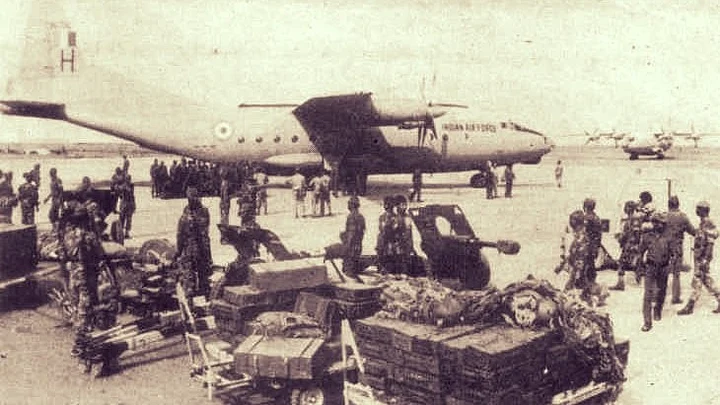The President of the Maldives Abdulla Yameen declared an emergency in the country on Monday, 5 February. The Chief Justice of the Supreme Court Abdulla Saeed was arrested, along with another Supreme Court Judge Ali Hameed on Monday. The military and police sealed off the country’s Parliament, and arrested former President Abdul Gayoom as well.
The former democratically-elected President of the Maldives, Mohamed Nasheed has asked India to send its army and help the country. Many members of the Indian and the international community have also asked whether India should step in like it did in 1988 during Operation Cactus, and play the saviour again.
But what was Operation Cactus? Read on.
What Happened?
A group of 80-200 Sri Lankan militants from the People’s Liberation Organisation of Tamil Eelam (PLOTE), backed by Maldivian businessman Abdulla Luthufi, mounted a coup in the Maldives in November 1988. After infiltrating the country’s capital of Male, the militants spread out and seized key areas in the city in an attempt to overthrow the then President Abdul Gayoom, Pragati reported.
Gayoom, however, escaped, taking refuge in the Maldives National Security Service headquarters.
The Maldives Reaches Out
President Abdul Gayoom reached out to a number of nations, including India, Pakistan, the United States, Britain, Malaysia, Sri Lanka and other states, Pragati added. Sri Lanka had commandos on standby, at its Ratmalana Air Base at Colombo. Malaysia was a good three to four days away from the Maldives by sea. The US and Britain, after talks, decided they wouldn’t intervene directly, but said they would coordinate a response with India.
Under the guidance of then Prime Minister Rajiv Gandhi, India responded with an overwhelming speed and efficiency.
Operation Cactus: India Jumps Into Action
At 1530 hours on 3 November 1988, India approved the dispatch of troops to the Maldives, said an excerpt from India’s Ocean: The Story Of India’s Bid For Regional Leadership by David Brewster.
Troops were deployed in one swift motion. Less than 16 hours since President Gayoom’s SOS call, Indian paratroopers were en route, leaving from the Agra Air Force Station on an Ilyushin Il-76 aircraft, The Wire reported, quoting an excerpt from. Operation Cactus: Mission Impossible in the Maldives by Sushant Singh.
After a journey covering over 2,500 kilometres, the aircraft of the 44 Squadron of the Indian Air Force landed at Hulhule Airport. Barely a kilometre from the besieged capital, the troops quickly began their advance into the capital.
The Militants’ Fatal Mistake
While the PLOTE militants seized many key points across the city, the one area they had forgotten to keep an eye on was Hulhule Airport. With no one keeping watch over this point of entry, Indian troops landed, and quickly took control of the airport, Operation Cactus: Mission Impossible in the Maldives adds. They then made their way into the capital using commandeered boats and rescued President Gayoom, driving out the militants.
Trapped, Cornered, And Nowhere to Run
A small vessel with a group of mercenaries, and carrying hostages, managed an escape while the Indian troops advanced and took back the capital. The vessel’s escape, while well-timed, would not be successful.
The INS Godavari and INS Betwa of the Indian Navy made sure of that. Two Sea-King Mk.42 choppers of the fleet dropped depth charges, blocking the mercenaries attempt to escape, Simply Decoded added, quoting David Brewster’s India’s Ocean: The Story Of India’s Bid For Regional Leadership.
While the vessel evaded arrest that day, it was boarded the next day by commandos of the Indian Marine Strike Force (Now known as the Marcos), and taken over with no incident.
A Succesful Mission
The mission was concluded with no casualties to the Indian side, save for one soldier who reportedly shot himself in the foot, Simply Decoded added quoting Brewster’s book again.
Operation Cactus was testimony to the fact that India could play a role in ensuring security in Asia. India’s swift, decisive action was hailed by the international community, ranging from US President Ronald Reagan to Margaret Thatcher, Pragati added.
India’s then-Cabinet Secretary, BG Deshmukh had this to say about Operation Cactus:
Operation Cactus enhanced India’s prestige enormously and showed our efficiency and capability to mount a successful operation at short notice. There was universal acknowledgement of our role as a police force in the area.BG Deshmukh
Will India step in again? Does the declaration of emergency in the Maldives warrant a similar response?
(With inputs from The Wire, Pragati, Simply Decoded, the Indian Air Force, India’s Ocean: The Story of India’s Bid for Regional Leadership, and Operation Cactus: Mission Impossible in the Maldives)
(At The Quint, we question everything. Play an active role in shaping our journalism by becoming a member today.)
